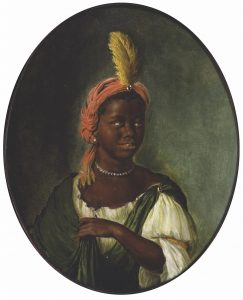
Willem van Mieris (Dutch, 1662–1747), An African Woman, c. 1710–1715. Oil on panel 7 1⁄16 x 5 13⁄16 in., Alvin and Carol Merlin Acquisition Fund and the Deaccession Fund, 2018.1
Set against a green background, an African woman wears a coral-colored turban, a prominent feather affixed with a gem clip. The textures are finely rendered, the gem and pearls shine, while her face and arm are particularly well modeled, marble-like. This diminutive tour de force by Willem van Mieris (1662–1747) is an extraordinary new acquisition, which will transform NOMA’s presentation of art of the global Dutch Golden Age.
This exquisite, small painting was made to imitate a portrait miniature, though it is almost certainly not a portrait. Rather, this beautiful woman is an artistic demonstration, a conceit. She is what the Dutch called a tronie, a fantasy or expressive head. The tronie type had its origins in workshop practice, intended as an exercise for young painters in depicting mood and emotion; the heads were likely based on models but not intended as portraits. The challenge to create a convincing individualization was matched by increasingly dramatic expressions and tricks of light and illusionism. In the early seventeenth-century, head studies came into their own, and for connoisseurs, the convincing deception was part of their wit and charm. Indeed, the world’s most famous tronie is Vermeer’s Girl with a Pearl Earring (c. 1665), painted a generation before Van Mieris’s picture.
Van Mieris trained and worked in the Dutch city of Leiden, a bustling yet small university town and textile manufacturing center south of Amsterdam. His father, Frans van Mieris (1635–1681), had been a leading figure of the Leiden school of “fine painters,” who created some of the most iconic works of Dutch Golden Age painting. As an artist of the younger generation, Willem positioned his art in relation to what came before, reworking the treasured subjects and illusionism the Dutch Golden Age painters created. This aspect of his work is fully exemplified in An African Woman, which refigures Vermeer’s Girl with a Pearl Earring (made in Delft) and references the work of earlier Leiden artists who made monumental tronies, Rembrandt in particular. Another Leidener who worked closely with Rembrandt on the tronie was Jan Lievens (Dutch, 1607–1674), whose Head of an Old Man is a beloved picture in NOMA’s collection.
The representation of sub-Saharan Africans was relatively common in Dutch art of this period. The Dutch East India Trading Company (the VOC) comprised a vast network of trading posts on the African coast along the trade routes to India and Southeast Asia. The bustling port of Amsterdam was one of the world’s most cosmopolitan places, and Africans are recorded there.
While Africans and other non-Europeans are represented in art of the period, the particular characterization of An African Woman is almost entirely unique. In most cases, the representation of Africans was restricted to three scenarios: as supplemental figures in biblical scenes to evoke the exotic locale of Jerusalem; as servants in interior scenes; and as allegorical figures of colonial possession and propaganda. Van Mieris’s singular presentation of this woman as a beauty, albeit an exotic one, is therefore extremely rare.
An African Woman represents an ambitious recombination of sources and motifs. The turbaned female head was a standard type, though Vermeer’s masterpiece provided the main point of departure. The distinct classicism of her costume and gesture along with the slick treatment of her skin are also hallmarks of Van Mieris’s style. Meanwhile, her facial features are related to both Rembrandt’s well-known ink drawings of Africans and the grand paintings commissioned for Amsterdam’s Town Hall, on which Rembrandt also worked. By combining a new classicizing style with a reformulation of a Dutch traditional type, the meditation on the past comes together into an entirely new, independent image.
For its depiction of and references to the material culture of the Dutch maritime empire, the rare representation of a non-European as a classical beauty (though fashioned in the European mold), and for its example as an artistic deception, An African Woman brings a significant new perspective to NOMA’s permanent collection.
—Vanessa Schmid, Senior Research Curator for European Art
Willem van Mieris’s An African Woman is on display in the newly reinstalled Dutch and Flemish Galleries on NOMA’s first floor.